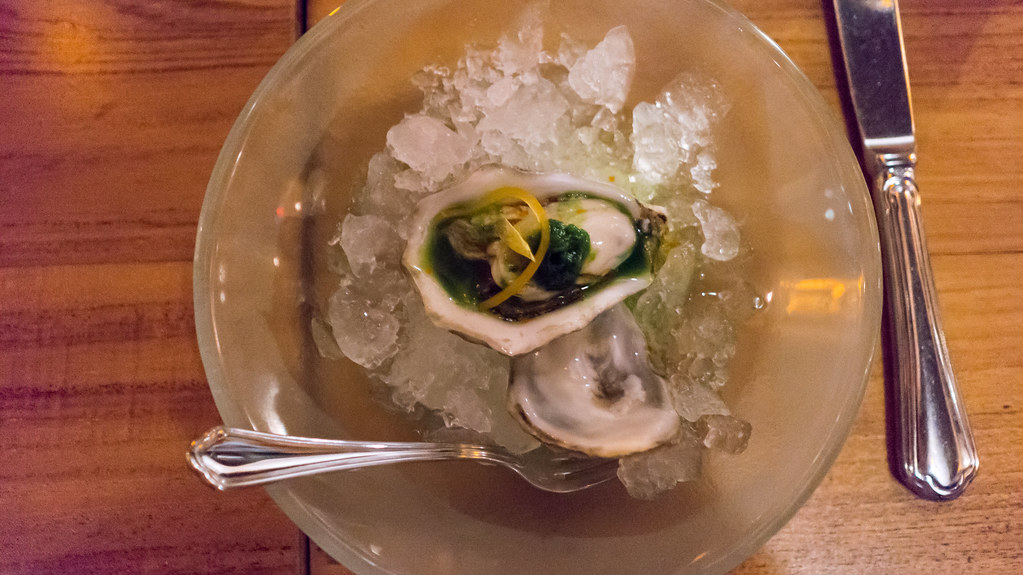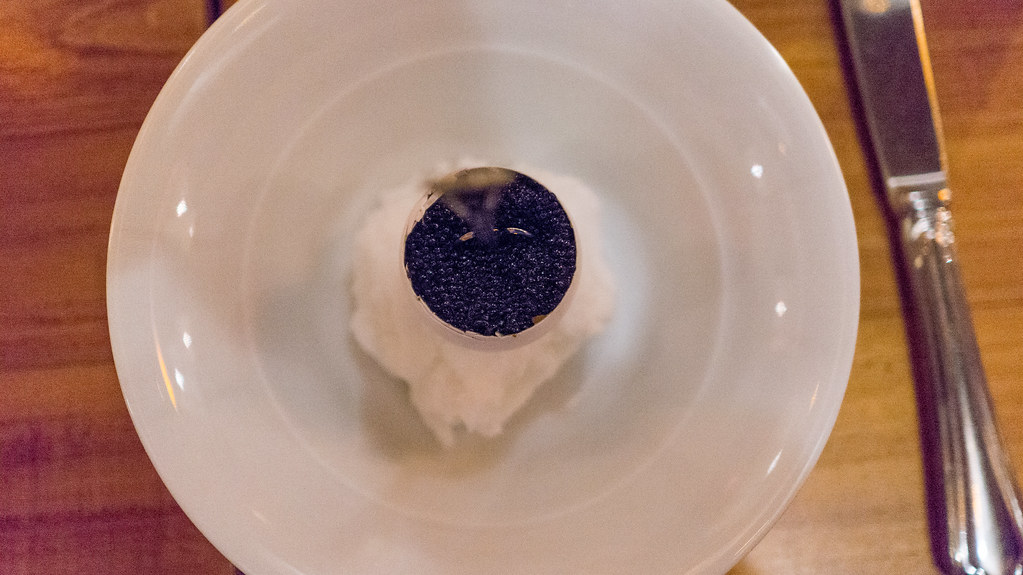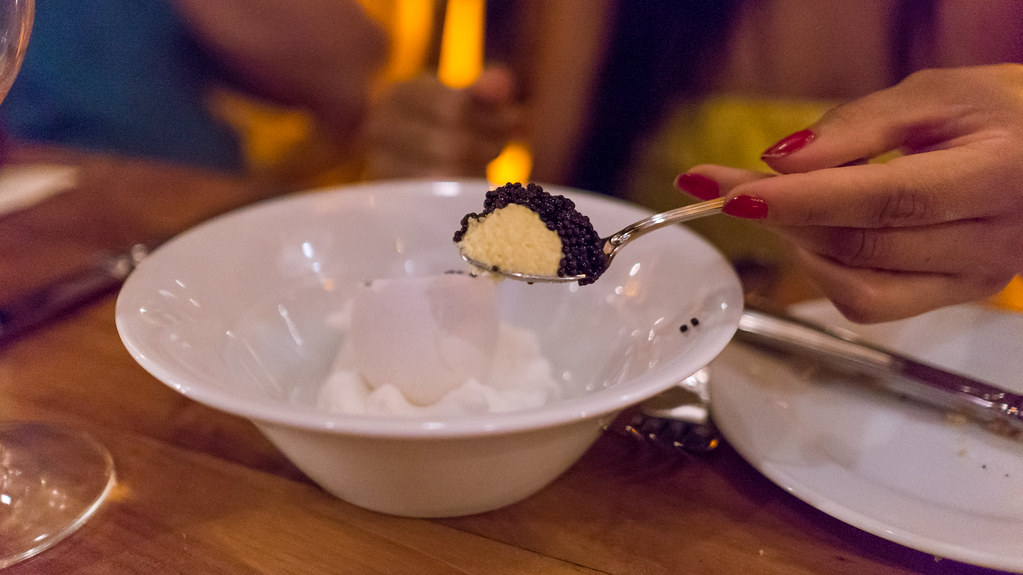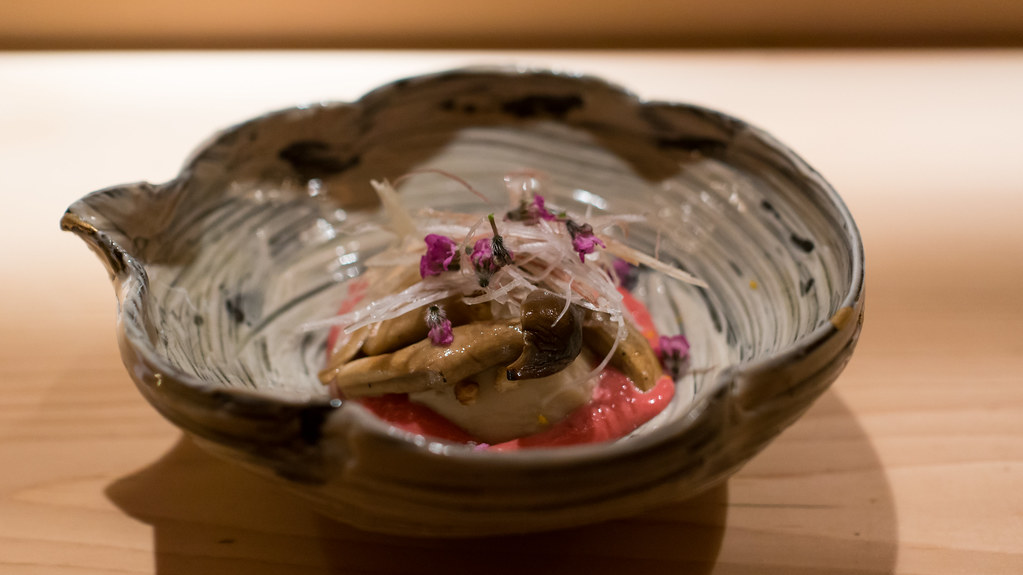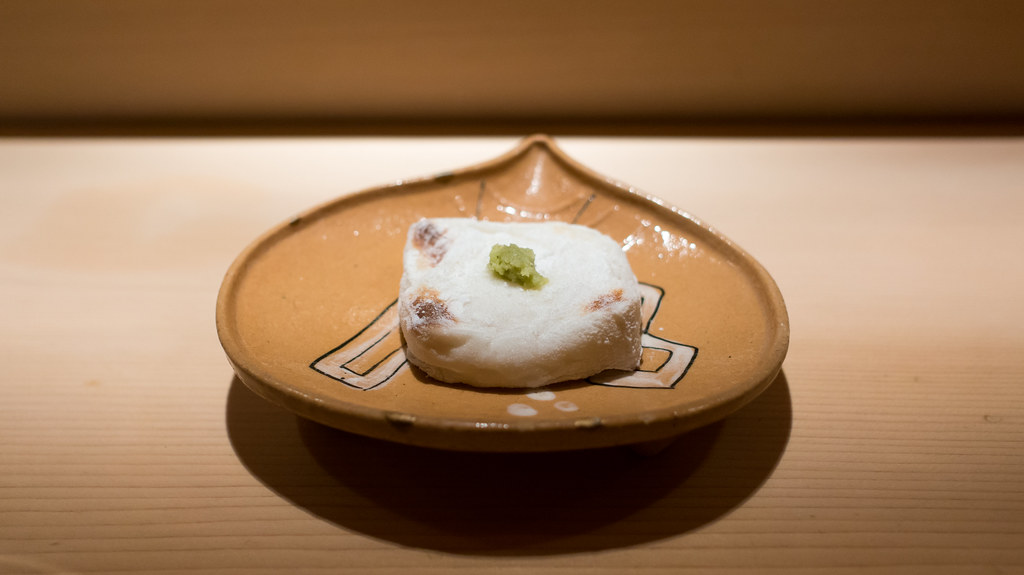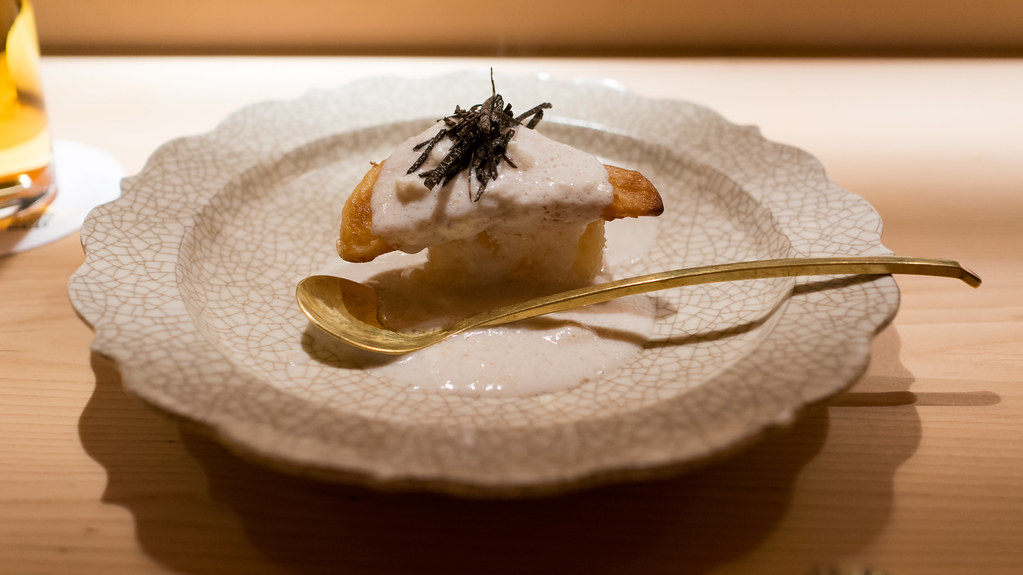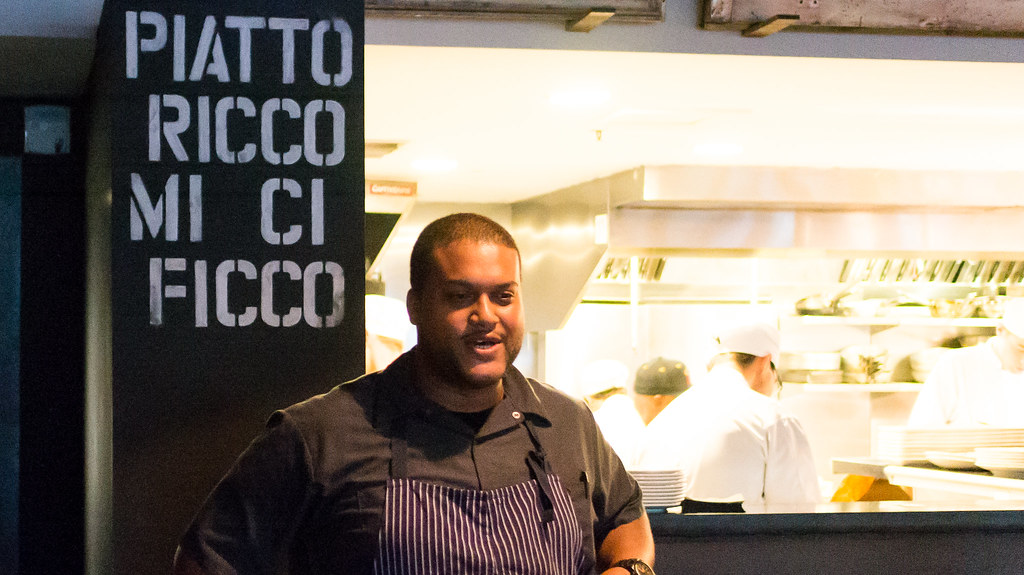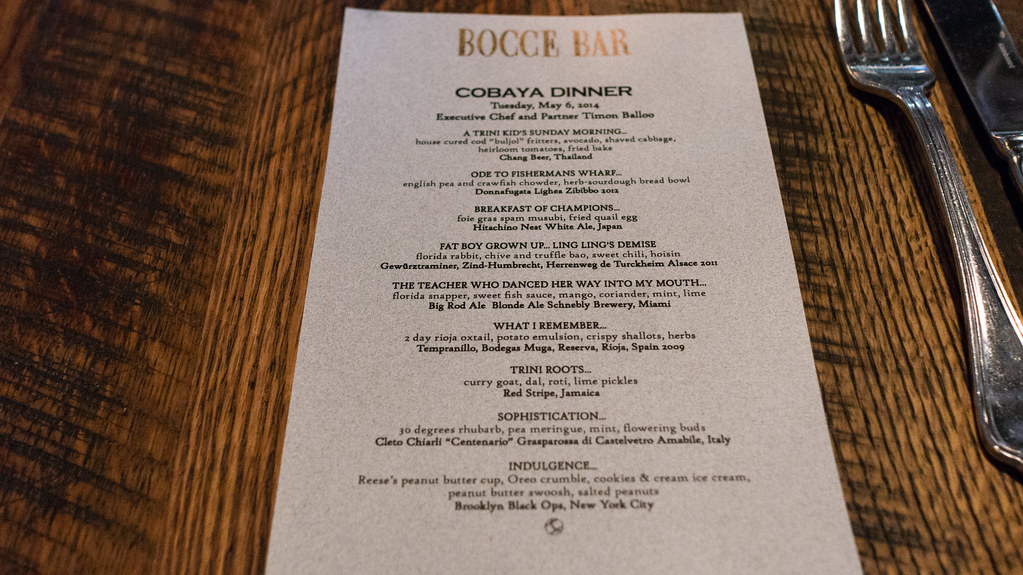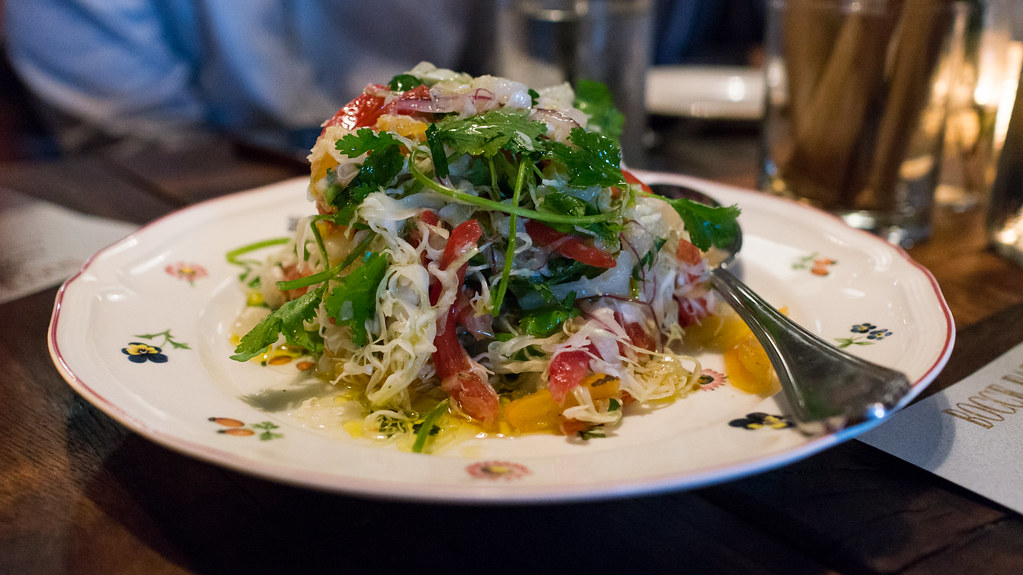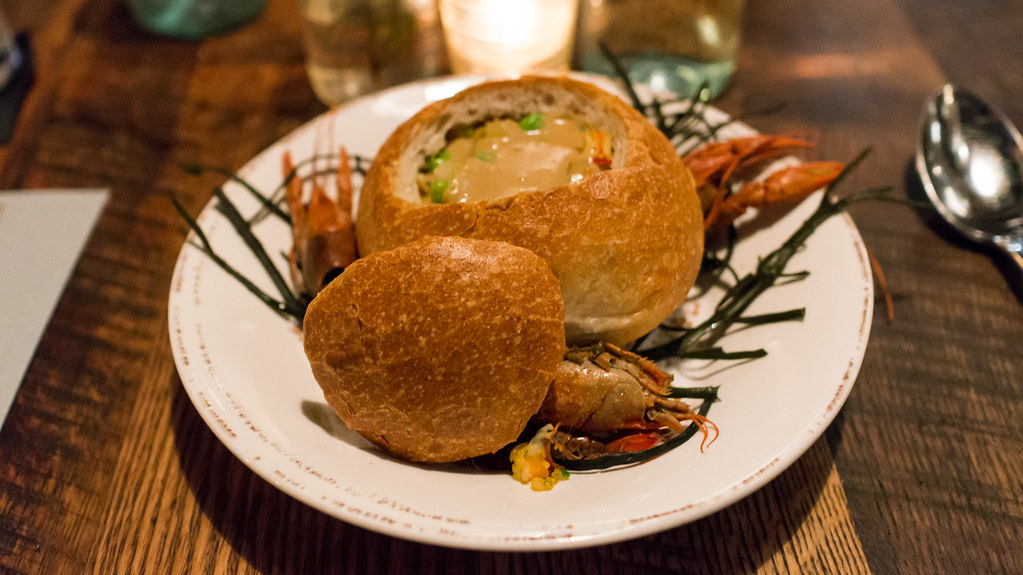Almost exactly two years ago we did a "Cobaya" dinner – Experiment #24 – at The Dutch. Number 24 was one of only two Cobaya dinners over the course of the past nearly five years that I couldn't attend. It was a tough one to miss – Chef Andrew Carmellini came down from New York and put on a show that many veteran guinea pigs say was among the best we've ever had.[1]
Since then, I've been to a number of great events at The Dutch: the Hurricane Sandy Relief Dinner we helped coordinate in late 2012, a really classy Spring Equinox Dinner that The Dutch's local chef de cuisine Conor Hanlon put on last year with chef Brad Kilgore (before Brad was hired at JG Grill), an indulgent "Trufflepalooza" a few months ago. But what I really wanted was another Cobaya, this one with Conor getting to do his thing. It came together this past week, and fortunately, I didn't miss this one.
We had a smaller group than usual – only 25 – at Conor's request, so that he could really focus and do more complex, individually plated items, rather than the family style service we've had at prior events. His menu spanned ten courses, each round dramatically delivered to the table simultaneously for all diners at once by a swat team of servers.
We started with a raw Stellar Bay oyster on crushed ice, garnished with a spicy, vegetal nasturtium granite, roasted tomato oil, celery, and Meyer lemon: a lot of flavors packed into one bite, designed to duplicate the flavors of a Bloody Mary.
Another spin on classic flavors: Conor's "Eggs on Eggs" packed a silky deviled egg farce into a cleaned eggshell, and then spackled the surface with a generously thick layer of black bowfin caviar. The briny saline pop of the roe was a nice contrast against the creamy, mildly spicy egg mousse.
I was floored, though, by the next course. A creamy, tangy buttermilk panna cotta served as the base for a composition that was like a spring cornucopia: stalks and spears of white and green asparagus, fresh shucked peas, golden-orange smoked trout roe, pickled mustard seeds, a tangle of delicate greens and flowers, all nestled into a bed of crispy dark brown quinoa. Every bite yielded a different combination of flavors, textures and colors. Just an outstanding dish.
(continued ...)
Tuesday, May 27, 2014
Wednesday, May 21, 2014
"west meets east" | Azabu Kadowaki - 麻布かどわき- Tokyo
Japan would seem to have a massive trade surplus when it comes to culinary inspiration. From the minimalist lightness of French nouvelle cuisine of the 1970's, to America's never-ending if not always quality-driven fixation on sushi, to "fusion" in so many guises, to this past decade's ramen craze, the traffic in ideas appears to be largely outbound. But Japan also absorbs influences too; and when it does so, it's usually with the same intense dedication to craft that pervades virtually all other pursuits there.[1]
Azabu Kadowaki is a resolutely Japanese restaurant; in fact, chef Toshiya Kadowaki was famed for turning down stars when the Michelin guide first came to Japan, on the basis that “Japanese food was created here, and only Japanese know it ... How can a bunch of foreigners show up and tell us what is good or bad?” (He ultimately relented, as the restaurant now has two of those stars that Kadowaki initially shunned.) But it also clearly bears the mark of some Western influences, filtered through a Japanese prism.
If I have my genres right, Kadowaki is a "kappo ryori" restaurant – high end food served straight from the kitchen, usually by the chef himself presenting it across the counter. It is an elegantly appointed space: honed wood counters and cabinets with the precision workmanship of a luxury yacht, cooking instruments all encased in patterned ceramic. There were maybe eight seats at the bar that faced that gorgeous open kitchen, though there appeared to be a couple private rooms as well that servers flitted in and out of.
(You can see all my pictures in this Azabu Kadowaki flickr set.)
The meal is omakase style: other than a diner's selection between snow crab and fugu as a "main" course, and between three different price points (all designated when the reservation is booked), everything else is chef's choice.
Our dinner started with an unusual and beautiful dish: a block of rich, nutty sesame tofu, nestled in a bed of magenta-hued beet miso, crowned with some meaty roasted mushrooms and bright purple flower buds. It defied any stereotype of a tofu-based dish being bland or insubstantial.
Almost simultaneously, we were also served a block of what I believe was either mochi or konnyaku (a/k/a yam cake or devil's tongue jelly). Toasted around the edges, it was chewy, almost elastic in texture, and blandly starchy in flavor other than the dab of freshly grated wasabi. It was texturally intriguing, but I can't say much more about it than that.
The next course was one of my favorites, blending eastern and western components: a cube of winter daikon radish draped with a slice of roasted pear, all enrobed in a creamy cod roe sauce and topped with a fine julienne of fresh black truffle. Cooked daikon is a highly underrated ingredient: tender but still having substance, silky but with a pleasing bite of graininess against the teeth, and a mild sweet flavor. Those qualities were mirrored and amplified by the roasted pear, which brought a more intense caramelized sweetness, the mildly salty, creamy sauce, and the earthy, aromatic truffle. There were no bold flavors here – rather it was all subtlety and grace.
(continued ...)
Azabu Kadowaki is a resolutely Japanese restaurant; in fact, chef Toshiya Kadowaki was famed for turning down stars when the Michelin guide first came to Japan, on the basis that “Japanese food was created here, and only Japanese know it ... How can a bunch of foreigners show up and tell us what is good or bad?” (He ultimately relented, as the restaurant now has two of those stars that Kadowaki initially shunned.) But it also clearly bears the mark of some Western influences, filtered through a Japanese prism.
If I have my genres right, Kadowaki is a "kappo ryori" restaurant – high end food served straight from the kitchen, usually by the chef himself presenting it across the counter. It is an elegantly appointed space: honed wood counters and cabinets with the precision workmanship of a luxury yacht, cooking instruments all encased in patterned ceramic. There were maybe eight seats at the bar that faced that gorgeous open kitchen, though there appeared to be a couple private rooms as well that servers flitted in and out of.
(You can see all my pictures in this Azabu Kadowaki flickr set.)
The meal is omakase style: other than a diner's selection between snow crab and fugu as a "main" course, and between three different price points (all designated when the reservation is booked), everything else is chef's choice.
Our dinner started with an unusual and beautiful dish: a block of rich, nutty sesame tofu, nestled in a bed of magenta-hued beet miso, crowned with some meaty roasted mushrooms and bright purple flower buds. It defied any stereotype of a tofu-based dish being bland or insubstantial.
Almost simultaneously, we were also served a block of what I believe was either mochi or konnyaku (a/k/a yam cake or devil's tongue jelly). Toasted around the edges, it was chewy, almost elastic in texture, and blandly starchy in flavor other than the dab of freshly grated wasabi. It was texturally intriguing, but I can't say much more about it than that.
The next course was one of my favorites, blending eastern and western components: a cube of winter daikon radish draped with a slice of roasted pear, all enrobed in a creamy cod roe sauce and topped with a fine julienne of fresh black truffle. Cooked daikon is a highly underrated ingredient: tender but still having substance, silky but with a pleasing bite of graininess against the teeth, and a mild sweet flavor. Those qualities were mirrored and amplified by the roasted pear, which brought a more intense caramelized sweetness, the mildly salty, creamy sauce, and the earthy, aromatic truffle. There were no bold flavors here – rather it was all subtlety and grace.
(continued ...)
Monday, May 19, 2014
CobayaBalloo - Chef Timon Balloo at Bocce Bar
I love a meal that tells a good story. A meal can be a journey – like Norman Van Aken's menus, traversing the flavors of the Caribbean, Asia, Latin America and Iberia. Some of the best are those that aspire to simply reflect a time and place – the flavor of the here and now, as Blaine Wetzel does to such great success at Willows Inn. Still others are more personal, attempting to recapture a particular taste memory or flavor sensation – that tunnel-vision view into a childhood experience so magnificently captured in the film Ratatouille.
This last type is often the most difficult to pull off, because there is no guarantee everyone has the same memory bank of experiences, or that they were absorbed in the same way. (For more thoughts on "story food" and capturing food memories, read this recent piece by Bruce Palling in "Cutting Edge Chefs Serve Up Food That Tells a Story"). Getting the backstory is helpful, which is part of why interaction can be a key to a meaningful dining experience.
Chef Timon Balloo took the autobiographical approach to the Cobaya dinner he put on last week, putting together a menu that told the story of his life in food. He also did a great job filling in the backstory which wound a meandering path from a Trinidadian childhood breakfast to the two Midtown Miami restaurants – Sugarcane Raw Bar Grill and Bocce Bar – that he runs today.
(You can see all my pictures in this CobayaBalloo flickr set).
Our group of nearly forty guinea pigs took over several large tables set in front of the open kitchen of Bocce Bar, which recently opened a few doors down from Sugarcane in the space which was formerly occupied by Sustain. As we always do, we told Timon that we didn't want "Sugarcane" food or "Bocce Bar" food – we wanted "Timon" food. He did exactly that, with a nine-course menu that paid tribute to his culinary influences and inspirations.
Growing up in a Trinidadian family, this was a typical weekend breakfast – salt cod tossed with shredded cabbage, tomatoes and fresh herbs, tucked into "bake," a simple, dense, chewy bread (you may have also heard of "Bake and Shark," another typical Trini recipe). This doesn't look or sound like much, but it was one of the dishes of the night for me, and a great start to our meal.[1] The snappy, spicy Chang Beer pairing was also right on target, as were all the pairings, which smartly and effectively featured beers as often as wines.
Chef Balloo spent some formative years in San Francisco, and while there are several potential candidates for an iconic San Francisco dish, the chowder in a sourdough bread bowl served at dozens of spots along Fisherman's Wharf may be the most ubiquitous. Timon stuck with the classic format but put a seasonal spin on the ingredients, subbing in a crawfish bisque studded with English peas for the typical clam and potato chowder.
(continued ...)
This last type is often the most difficult to pull off, because there is no guarantee everyone has the same memory bank of experiences, or that they were absorbed in the same way. (For more thoughts on "story food" and capturing food memories, read this recent piece by Bruce Palling in "Cutting Edge Chefs Serve Up Food That Tells a Story"). Getting the backstory is helpful, which is part of why interaction can be a key to a meaningful dining experience.
Chef Timon Balloo took the autobiographical approach to the Cobaya dinner he put on last week, putting together a menu that told the story of his life in food. He also did a great job filling in the backstory which wound a meandering path from a Trinidadian childhood breakfast to the two Midtown Miami restaurants – Sugarcane Raw Bar Grill and Bocce Bar – that he runs today.
(You can see all my pictures in this CobayaBalloo flickr set).
Our group of nearly forty guinea pigs took over several large tables set in front of the open kitchen of Bocce Bar, which recently opened a few doors down from Sugarcane in the space which was formerly occupied by Sustain. As we always do, we told Timon that we didn't want "Sugarcane" food or "Bocce Bar" food – we wanted "Timon" food. He did exactly that, with a nine-course menu that paid tribute to his culinary influences and inspirations.
"A Trini Kid's Sunday Morning"
house cured cod "buljol" fritters, avocado, shaved cabbage, heirloom tomatoes, fried bake
Chang Beer, Thailand
Growing up in a Trinidadian family, this was a typical weekend breakfast – salt cod tossed with shredded cabbage, tomatoes and fresh herbs, tucked into "bake," a simple, dense, chewy bread (you may have also heard of "Bake and Shark," another typical Trini recipe). This doesn't look or sound like much, but it was one of the dishes of the night for me, and a great start to our meal.[1] The snappy, spicy Chang Beer pairing was also right on target, as were all the pairings, which smartly and effectively featured beers as often as wines.
"Ode to Fisherman's Wharf"
english pea and crawfish chowder, herb-sourdough bread bowl
Donnafugata Lighea Zibibbo 2012
Chef Balloo spent some formative years in San Francisco, and while there are several potential candidates for an iconic San Francisco dish, the chowder in a sourdough bread bowl served at dozens of spots along Fisherman's Wharf may be the most ubiquitous. Timon stuck with the classic format but put a seasonal spin on the ingredients, subbing in a crawfish bisque studded with English peas for the typical clam and potato chowder.
(continued ...)
Subscribe to:
Posts (Atom)


